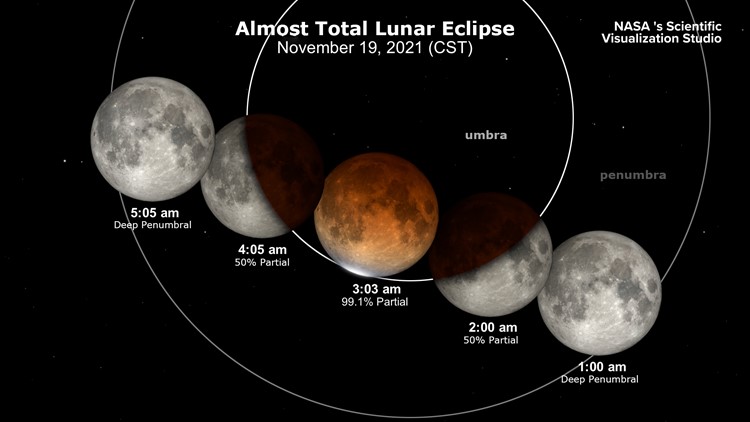CALIFORNIA, USA — A partial total lunar eclipse will be viewable on the West Coast on Nov. 19.
The full moon is going to be almost fully eclipsed by Earth's shadow. What's happening is the Earth will be between the sun and the moon in a straight line.
Over on the West Coast, the partial eclipse will begin at 11:18 p.m. on Thursday, November 18. The maximum eclipse will happen at 1:02 a.m. on Friday, November 19. This is the reason why it's called a partial total lunar eclipse; there's just the tiniest sliver of the moon being illuminated by the sun. Otherwise, it's covered by Earth's shadow.
The partial eclipse ends around 2:47 a.m., so this is going to stretch from Thursday night into Friday morning.
As the eclipse starts to pass through the darkest shadow, the umbra, it's going to take on a coppery red glow, and then it's going to start to exit. That's the point where you can see that little sliver. A depiction of that process is viewable in the visualization from NASA HERE.
As it starts to exit, it will lose that rosy glow and return to it's normal white color.
The eclipse is going to be visible throughout all of North America and most of South America, but everywhere else, it's not really visible.
The moon is going to be 97% eclipsed for 208 minutes and 23 seconds. According to Butler University's Holcomb Observatory, the phenomenon will be the longest of its kind in 580 years. In other words, that's going to be the longest partial eclipse that we've had between 1440 to 2669. Our next eclipse is going to be happening with the total lunar eclipse for the Western U.S. on May 15 and again Nov. 8 in 2022.
Seeing the celestial event may be challenging by Thursday. A weather system is on the move which helped clear the fog, but will bring a chance of rain.
Clouds will increase Thursday so much of the Sacramento Valley and northern California will miss a clear view of the eclipse. However, some parts of the South Bay Area, Central Sierra and surrounding foothills could see the beginning but clouds will continue to increase likely obscuring the peak.
READ ALSO:
WATCH ALSO:





















